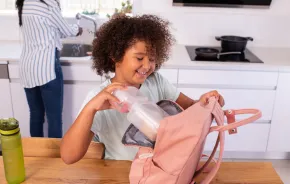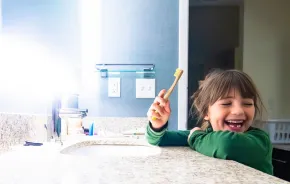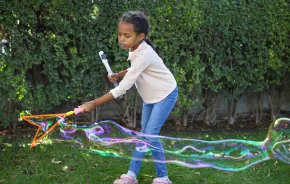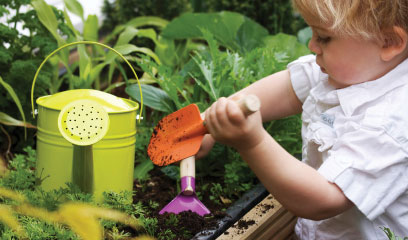 Dust off those gardening gloves and get ready to head outside — it’s finally spring! Gardening is one healthy, eco-friendly hobby that can offer up a bounty of hands-on learning experiences — with roots that grow much deeper than just digging in the dirt.
Dust off those gardening gloves and get ready to head outside — it’s finally spring! Gardening is one healthy, eco-friendly hobby that can offer up a bounty of hands-on learning experiences — with roots that grow much deeper than just digging in the dirt.
Even toddlers can get in on the fun and play an important role with the family garden. Granted, this may mean picking ripe strawberries for an afternoon snack or simply digging seed holes for Mom, but still! There is so much fun to be had and plenty to learn when it comes to sprouting seeds.
Life in their hands (and mouths)
Seattle Tilth’s Lisa Taylor couldn’t be more excited to get her students digging in the soil. “Gardening teaches children great stewardship and respect,” says Taylor. “It helps kids know where their food comes from and how it grows; how to care for living creatures.”
Taylor’s students, ages 2 and older, learn to be responsible for many gardening tasks, including tending the worm bins, planting, harvesting and watering. In fact, the only tasks they don’t do are heavy lifting and pruning. “Capacity in the garden grows with age and skill, but kids are capable of all gardening work … as long as you teach them,” Taylor says.
However, Taylor isn’t afraid to reveal that she’s learned quite a bit from her students as well. “I’ve learned more about bugs than I ever thought possible,” she laughs. “It’s remarkable how a tiny sal bug can become so beloved and teach us so much about the meaning of life.”
And if you’ve got a picky eater on your hands, you’re certainly in luck — kids are much more likely to eat their veggies when they’ve just been pulled fresh from the soil. Fircrest mom J.J. Ordway admits that although her 2- and 4-year-olds may always choose a berry over a green bean, they’re much more interested overall in trying new fruits and veggies from the garden, rather than from the grocery store.
West Seattle mother Cynthia Tamlyn couldn’t agree more: “When the seeds grow and produce, the kids are excited to try their new food. My son was the proverbial picky eater; now he’ll ask for an artichoke for dessert!”
Setting rules & giving room
However you choose to set up your garden space, be sure to discuss clear ground rules that everyone in the family can follow. Seattle Tilth teaches young gardeners where feet go in relation to the garden beds, how one walks in the garden and that an adult must give permission before plants are picked or eaten. “Children are naturally nurturing and they understand the importance of caring for living things,” says Taylor.
To make it easy for children to obey the rules, Taylor recommends allowing a space for whatever they desire. Whether this is a corner of the family garden or their very own dirt bed, this area can be used for digging, playing and outdoor creativity — not necessarily for planting.
Gretchen O’Byrne, a West Seattle resident, says her 4-year-old daughter loves having her own space. “I’ve learned that I need to keep my garden separate from her garden, because I was giving her too much direction and basically ruining her fun. She needs to explore and see what happens.”
In her new book, Your Farm in the City, Taylor also stresses the importance of creating clear garden paths for kids. “Children take up a lot of space as they learn to move and control their bodies,” Taylor writes. “Paths should be two feet wide and covered with a unique identifiable material . . . so it is easy to see where plants and people go.”
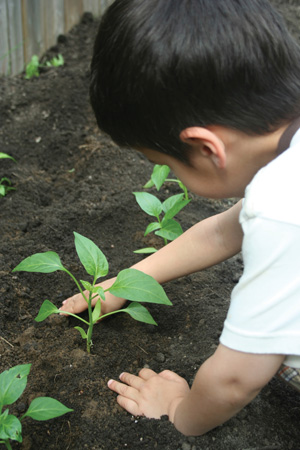 Stir the mix for sensory stimulation
Stir the mix for sensory stimulation
Just as your child may love the sensory table at school, the variety of plants and vegetables that a backyard garden can offer is sure to amaze all summer. When planning your family garden, consider different sizes, shapes, smells, textures, colors and most importantly, the different tastes that you hope to include. Taylor recommends going both big and small when it comes to size. “Children tend to love plants that are either gigantic or teeny tiny miniatures.”
Vibrantly colored plants are also a definite crowd pleaser with the Seattle Tilth students. These could include rainbow chard, strawberries, rhubarb, cabbage, pumpkins, peppers and heirloom tomatoes.
With preschoolers, you may also want to add a good variety of root vegetables, such as potatoes, radishes, carrots and beets. Sure, these veggies are fantastic for future family dinners, but the sheer joy of pulling them out of the ground when they are ready can be one of summer’s biggest highlights — even for the adults!
Child safety first
Sharman Ghio of Orange Blossom Society and Taylor both suggest sticking to organic gardening remedies, rather than using store-bought products with harsh chemicals. “We don’t use any pesticides in the Orange Blossom Society garden, which makes it safe for the children, but difficult to combat pests,” says Ghio. “It just takes a little more work and creativity to get the desired results.” Taylor also advises growing only edible plants and avoiding anything poisonous, such as aconites, foxglove, caladium or delphinium.
Dig in!
Ghio urges parents to slow down and to be careful when it comes to thinking about the garden’s success. “Be patient, set realistic expectations and most of all, enjoy the day-to-day experiences. A successful garden means different things to different people, so don’t be disappointed if it turns out differently than you expected.”
Taylor agrees and reminds parents that even in the garden, kids are still kids. “Know that kids are messy and erratic . . . but a whole lot of fun in the garden. They’re learning!”
Jen Betterley is ParentMap’s web editor. She can typically be found digging in her own garden’s dirt each weekend.
10 tips for gardening with your children
1. Invite them to garden with you.
2. Grow only edible plants.
3. Make paths wide and obvious.
4. Build a teepee or tunnel on which to grow peas or beans.
5. Give kids a plot of their own.
6. Start a worm bin.
7. Teach them how to walk in the garden and how to use tools.
8. Provide a patch of ground for digging.
9. Leave weedy patches for creature habitat.
10. Plant things that are easy to grow and that you like to eat.








